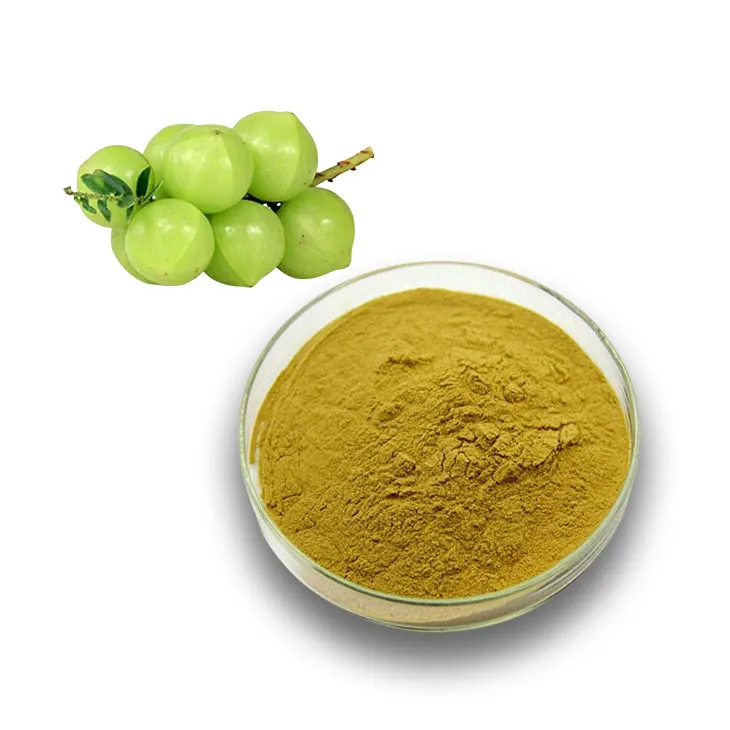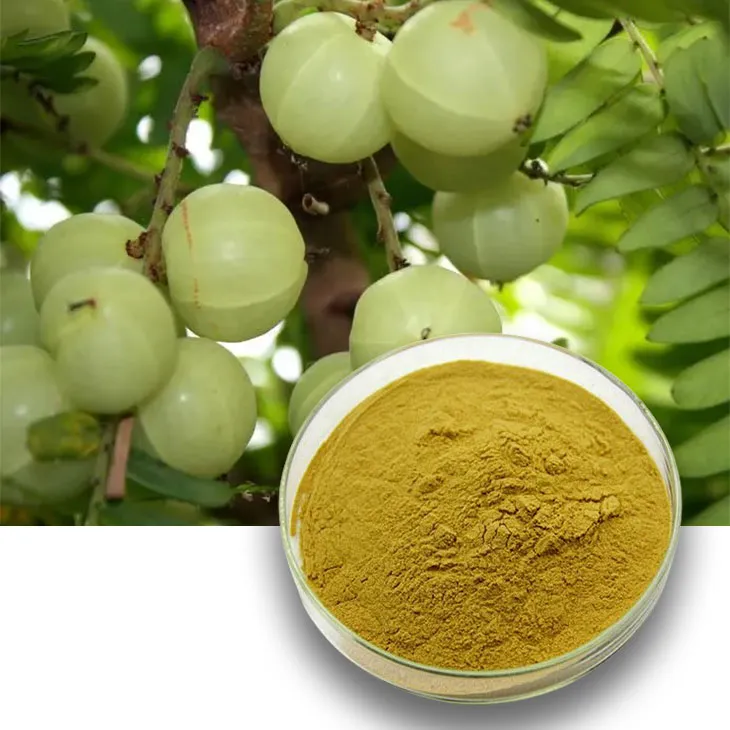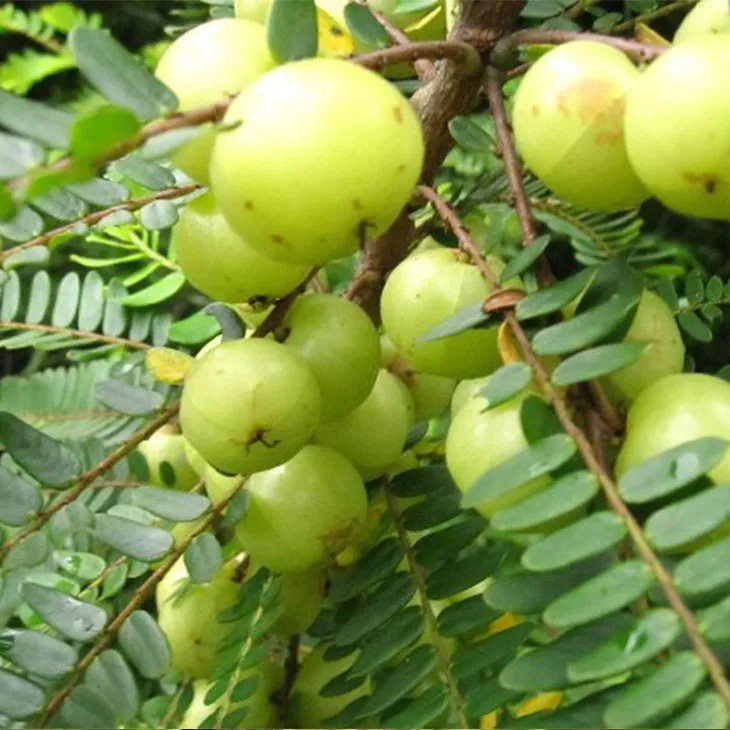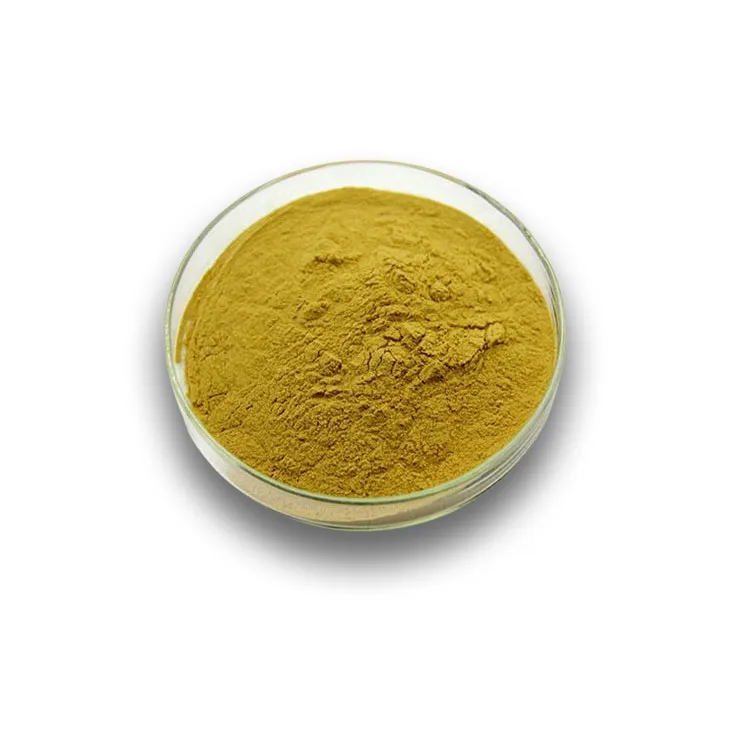- 0086-571-85302990
- sales@greenskybio.com
Extraction process of Phyllanthus emblica extract.
2024-11-30

1. Introduction
Phyllanthus emblica, also known as Indian gooseberry, is a plant rich in various bioactive compounds. The extraction of its extract is of great significance for applications in medicine, cosmetics, and food industries. The extraction process is a complex and multi - step procedure that aims to obtain the desired active ingredients effectively and efficiently.

2. Sample Preparation
The first crucial step in the extraction of Phyllanthus Emblica Extract is sample preparation. This involves carefully selecting and preparing the Phyllanthus emblica samples.
2.1 Selection
High - quality Phyllanthus emblica fruits are chosen. It is essential to avoid fruits that are damaged, diseased, or unripe. Damaged parts may introduce contaminants or degraded compounds, while unripe fruits may not contain the full spectrum of desired bioactive components.
2.2 Cleaning
The selected Phyllanthus emblica fruits are thoroughly washed to remove any dirt, debris, or surface contaminants. This can be done using clean water, and in some cases, mild detergents may be used followed by thorough rinsing to ensure no detergent residue remains.
2.3 Drying
After cleaning, the fruits may need to be dried. Drying can be carried out using natural air - drying methods in a well - ventilated area. Alternatively, low - temperature drying techniques such as vacuum drying or freeze - drying can be used to preserve the integrity of the bioactive compounds. The dried fruits are then ready for the extraction process.

3. Traditional Extraction Methods
Traditional extraction methods have been used for a long time to obtain Phyllanthus Emblica Extract. One of the most common traditional methods is maceration.
3.1 Maceration Process
- First, the dried Phyllanthus emblica fruits are crushed into smaller pieces. This increases the surface area available for extraction, allowing the solvent to better penetrate the plant material.
- Then, a suitable solvent is selected. Commonly used solvents include ethanol, methanol, and water or a combination of these. The crushed Phyllanthus emblica is soaked in the solvent.
- The soaking process is carried out for an extended period, which can range from several hours to several days. During this time, the solvent gradually diffuses into the cells of the Phyllanthus emblica. The bioactive compounds in the cells are then dissolved in the solvent due to the difference in concentration gradients between the inside and outside of the cells.
- After the soaking period, the resulting mixture contains the extract along with the solid plant material. This mixture needs to be further processed to separate the extract from the plant debris.
3.2 Advantages and Disadvantages of Maceration
- Advantages: Maceration is a relatively simple and low - cost method. It does not require complex equipment, making it accessible in many small - scale extraction operations. It also allows for a relatively gentle extraction, which can be beneficial for preserving the integrity of some heat - sensitive compounds.
- Disadvantages: The long extraction time is a major drawback. It also has relatively low extraction efficiency compared to some modern extraction methods. Additionally, a large amount of solvent is often required, which may increase the cost and environmental impact if the solvent is not properly recycled.

4. Modern Extraction Methods
With the development of technology, modern extraction methods have emerged to overcome the limitations of traditional methods. One such method is microwave - assisted extraction.
4.1 Microwave - Assisted Extraction Process
- The dried and crushed Phyllanthus emblica is placed in a suitable extraction vessel along with the chosen solvent.
- Microwave energy is then applied to the system. The microwave radiation causes the polar molecules in the solvent and the plant cells to vibrate rapidly. This rapid vibration generates heat, which in turn increases the temperature of the extraction system.
- The increased temperature and the microwaves' unique effect on the plant cell walls enhance the mass transfer of the active ingredients from the Phyllanthus emblica to the solvent. This results in a faster extraction process compared to traditional maceration.
- Similar to maceration, after the extraction, the resulting mixture needs to be further processed to separate the extract from the solid material.
4.2 Advantages and Disadvantages of Microwave - Assisted Extraction
- Advantages: The most significant advantage is the shorter extraction time. It can significantly reduce the extraction duration compared to maceration, which is highly beneficial for large - scale industrial production. It also has relatively high extraction efficiency, meaning more of the desired bioactive compounds can be extracted in a shorter time. Moreover, it can often use less solvent, which is more environmentally friendly and cost - effective.
- Disadvantages: Microwave - assisted extraction requires specialized microwave - enabled equipment, which is more expensive than the simple vessels used in maceration. There is also a risk of over - heating the sample if the microwave parameters are not properly controlled, which may lead to the degradation of some heat - sensitive compounds.

5. Separation of the Extract
After the extraction process, whether it is by maceration or microwave - assisted extraction, the next step is to separate the Phyllanthus Emblica Extract from the solid plant debris. One common method for this separation is centrifugation.
5.1 Centrifugation Process
- The extraction mixture, which contains the extract dissolved in the solvent and the solid plant material, is transferred to centrifuge tubes.
- The centrifuge tubes are then placed in a centrifuge. The centrifuge rotates at a high speed, typically ranging from several thousand to tens of thousands of revolutions per minute (rpm).
- Due to the centrifugal force, the denser solid particles are forced to the bottom of the centrifuge tubes, while the supernatant, which contains the Phyllanthus emblica extract dissolved in the solvent, remains on top.
- The supernatant can then be carefully decanted or pipetted out for further processing, leaving the solid debris at the bottom of the tubes.
5.2 Other Separation Methods
- Filtration is another possible method for separating the extract. A filter paper or a membrane filter can be used. However, filtration may be slower and less efficient than centrifugation, especially for samples with fine solid particles.
- Decantation can also be used in some cases where the solid particles are relatively large and settle quickly. However, this method may not be very accurate and may result in some solid particles being carried over with the supernatant.
6. Post - Extraction Processing
Once the Phyllanthus emblica extract has been separated from the solid debris, it may need further processing for different applications.
6.1 Concentration
If the extract is too dilute, it may be necessary to concentrate it. This can be done by evaporation of the solvent under reduced pressure. By reducing the pressure, the solvent can be evaporated at a lower temperature, which helps to preserve the bioactive compounds in the extract.
6.2 Freeze - Drying
- Freeze - drying, also known as lyophilization, is a popular method for further processing the Phyllanthus emblica extract. In this process, the extract is first frozen at a very low temperature.
- Then, under a vacuum, the ice in the frozen extract is directly sublimated into vapor without passing through the liquid phase. This results in a dry powder form of the extract.
- The freeze - dried Phyllanthus emblica extract has several advantages. It has a long shelf - life, is easy to store and transport, and can be easily reconstituted when needed for use in various applications such as in the formulation of drugs, cosmetics, or food supplements.
7. Conclusion
The extraction process of Phyllanthus emblica extract involves multiple steps from sample preparation to post - extraction processing. Traditional methods like maceration and modern methods such as microwave - assisted extraction each have their own advantages and disadvantages. The choice of extraction method depends on various factors such as the scale of production, the desired quality of the extract, and cost - effectiveness. Regardless of the method used, proper separation and post - extraction processing are crucial to obtain a high - quality Phyllanthus emblica extract that can be effectively used in different fields.
FAQ:
What are the main extraction methods for Phyllanthus emblica extract?
The main extraction methods for Phyllanthus emblica extract include maceration and microwave - assisted extraction. In maceration, the Phyllanthus emblica is crushed and soaked in a suitable solvent for a long time. Microwave - assisted extraction uses microwave energy to speed up the extraction process by promoting the mass transfer of active ingredients from the plant material to the solvent.
Why is it necessary to prepare Phyllanthus emblica samples before extraction?
Before extraction, it is necessary to prepare Phyllanthus emblica samples by removing damaged or unripe parts. This is to ensure the quality of the extract. Damaged or unripe parts may contain different compounds or have a negative impact on the extraction process, and removing them can help to obtain a more pure and effective extract.
How does maceration work in the extraction of Phyllanthus emblica extract?
In the maceration method for Phyllanthus emblica extract extraction, the Phyllanthus emblica is first crushed. Then it is soaked in a suitable solvent for an extended period. During this time, the solvent gradually enters the cells of Phyllanthus emblica, allowing the desired compounds to be extracted into the solvent.
What is the role of centrifugation in the extraction process of Phyllanthus emblica extract?
Centrifugation is used in the extraction process of Phyllanthus emblica extract to quickly separate the supernatant containing the extract from the solid debris. This helps to purify the extract and obtain a more concentrated and pure form of the Phyllanthus emblica extract.
Why is freeze - drying often used for the resulting Phyllanthus emblica extract?
Freeze - drying is often used for the resulting Phyllanthus emblica extract to obtain it in a powder form. This powder form is easier to store and transport. It also has better stability and can be more conveniently applied in different fields.
Related literature
- “Studies on the Chemical Constituents of Phyllanthus emblica Extract”
- “Optimization of Extraction Process for Phyllanthus emblica Extract”
- “Bioactive Compounds in Phyllanthus emblica Extract: Extraction and Applications”
- ▶ Hesperidin
- ▶ citrus bioflavonoids
- ▶ plant extract
- ▶ lycopene
- ▶ Diosmin
- ▶ Grape seed extract
- ▶ Sea buckthorn Juice Powder
- ▶ Beetroot powder
- ▶ Hops Extract
- ▶ Artichoke Extract
- ▶ Reishi mushroom extract
- ▶ Astaxanthin
- ▶ Green Tea Extract
- ▶ Curcumin Extract
- ▶ Horse Chestnut Extract
- ▶ Other Problems
- ▶ Boswellia Serrata Extract
- ▶ Resveratrol Extract
- ▶ Marigold Extract
- ▶ Grape Leaf Extract
- ▶ blog3
- ▶ blog4
-
Honeysuckle pollen of the best quality.
2024-11-30
-
Chinese Senna Leaf Extract Suppliers.
2024-11-30
-
Organic Dandelion Root Extract, Australia.
2024-11-30
-
The best bitter gourd extract in 2024.
2024-11-30
-
The best baicalin in nature.
2024-11-30
-
Chinese lily extract manufacturers.
2024-11-30
-
Nature's best β - carotene.
2024-11-30
-
Standard - process Coenzyme Q10.
2024-11-30
-
Gynostemma pentaphyllum extract
2024-11-30
-
Camu Camu Extract
2024-11-30
-
Maitake Mushroom Extract
2024-11-30
-
Green coffee bean Extract
2024-11-30
-
Propolis Extract Powder
2024-11-30
-
Curcuma Longa Extract
2024-11-30
-
Phyllanthus Emblica Extract
2024-11-30
-
Thunder God Vine Extract
2024-11-30
-
Saw Palmetto Extract
2024-11-30
-
Cranberry Extract
2024-11-30




















